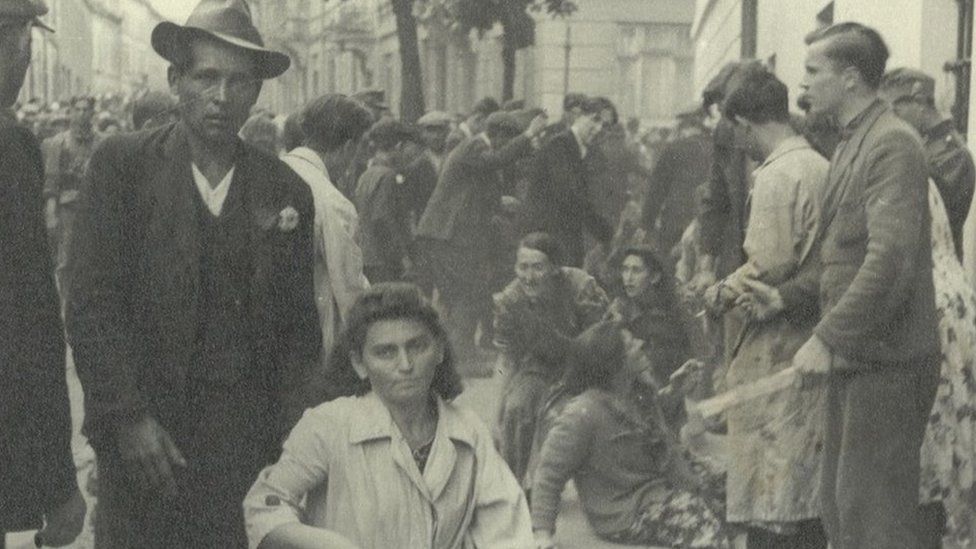The Nightingale’s Bloody Roost

 Deborah L. Armstrong
Deborah L. Armstrong
Crossposted with Medium
* The wanton atrocities of Bandera and Shukhevich
* Bandera’s assassination by a love-torn KGB spy
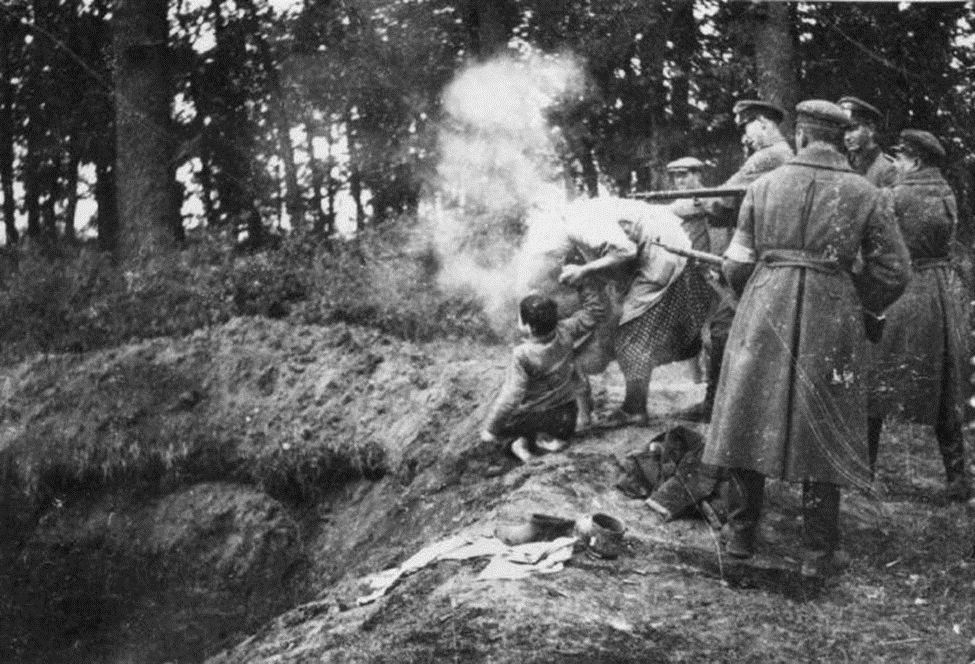
Ukrainian auxiliary police murder a mother and child in Miropol, USSR, 1941. Photo credit: static01/nyt.com
“The OUN values the life of its members, values it highly; but — our idea in our understanding is so grand, that when we talk about its realization, not single individuals, nor hundreds, but millions of victims have to be sacrificed in order to realize it.”
— Stepan Bandera
In part one of this investigative report, we took a look at just some of the atrocities committed by Stepan Bandera and his followers — Nazi collaborators who tried to purge all Jews, Romani, Poles and Russians from future Ukrainian lands.
There was, as you saw, no crime too vile for the Organization of Ukrainian Nationalists — the OUN. The sheer brutality of these crimes cannot be over-emphasized, and bodies are still being dug up today.
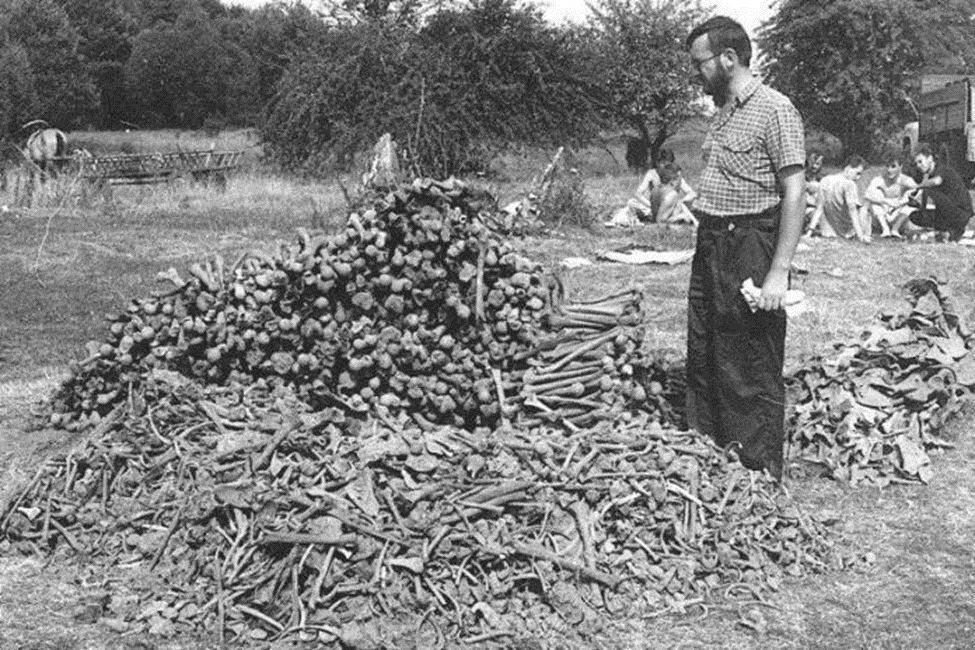
Exhumed remains of OUN victims, Poland, 1990s. Photo credit: kresky.pl
One of the most comprehensive articles I came across while researching Bandera was published by Covert Action Magazine, in three parts. I highly recommend this article, written by Evan Reif, to anyone who is serious about understanding these dark chapters of Ukraine’s history. Much of the information to follow was gleaned from this seminal work. Reif’s article delves more deeply into the origins and history of the OUN, which I will summarize here.
The OUN was founded in 1929 from the ashes of the Ukrainian Military Organization, the UVO. The UVO was formed in 1920 by right-wing Austro-Hungarian veterans of the First World War. The UVO waged a terrorist campaign against the Soviets and the Poles, operating primarily in western Ukraine, which was occupied by Poland in those days.
The Polish government at that time was an unpopular far-right regime which implemented land reform and language laws. However, it was not the government which the UVO primarily targeted, but civilians. The Ukrainian militants worked like bandits, hitting villages, towns, and small farming communities. They tortured, raped, killed, looted, burned everything to the ground, and moved on. They knew better than to attack the military or police, which might have decimated their numbers. They were a scourge on the countryside, waging a war on farmers and peasants — men, women and children of all ages.
It is a cautionary tale for Russia today, that the Soviets, who controlled Ukraine for so many years, could not or did not stamp out the Nazi ideological infestation.—The Editor
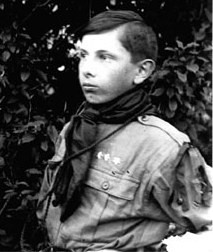
Bandera in his Plast uniform. Photo credit: Wikipedia
It was in the early 1920’s when the UVO began its official collaboration with the Germans. From 1921 until 1928, the UVO received millions of marks in aid from Germany. Due to pressure from the Soviet and Polish governments, the leaders of the UVO were eventually moved to Berlin and when the Nazis came to power, the collaboration continued.
As the years went by, the OUN took center stage, led by ever-younger, more radical members, and the UVO fell to the wayside, its role diminished. One of those young leaders was Stepan Bandera, a fascist since childhood. Bandera was born on January 1, 1909 to a Greek Catholic family, the son of a priest.

Original “Plast” symbol. Photo credit: Livejournal
As a child, Bandera was a member of “Plast,” a fascist youth group. That group has been reestablished in recent times, though its webpage makes it appear friendly enough, with wholesome pictures of children learning scouting skills, canoeing, and performing good deeds for the community. The same symbol appears on Plast uniforms today, only without the swastika of old. But the topic of fascist indoctrination of children in Ukraine will have to be reserved for another article.
As a young adult, Bandera moved up quickly in the ranks of the OUN, first serving as the chief propaganda officer in 1931, at the age of 22. He quickly became the second in command of the OUN in Galicia 1932 and was named head of the OUN National Executive in 1933.
Bandera was a rabid fascist who despised Jews, communists, Gypsies, Hungarians, Poles and Russians. He wanted to reclaim lands that had not been Ukrainian for centuries and violently purge all non-Ukrainians from the territory. Bandera radicalized the OUN, adding to its membership, making it larger and more efficient. In 1934, members of the OUN-B (the B denoting Bandera’s leadership) assassinated Polish foreign minister Bronisław Pieracki by shooting him at close range with a pistol.
Bandera was captured by Polish authorities and sentenced to die with other OUN leaders, but the death sentence was commuted to life and when the Nazis invaded Poland in 1939, Bandera was released. The Nazi Abwehr, German intelligence, employed Bandera and the OUN in 1940 and began preparing for Operation Barbarossa, the invasion of the USSR.
Bandera and the OUN were chosen by the highest-ranking German officers including Adolf Hitler, who instructed them to carry out brutal reprisals and terrorism against civilians in the Soviet Union. General Erwin von Lahousen testified about this at the Nuremberg trials.
But Bandera’s antagonistic personality style and his demands for Ukrainian independence at any cost split the OUN in two, with Bandera leading the OUN-B, and Andriy Melnyk, who favored a more subservient role with the Nazis, leading OUN-M.
The rift between the two groups became violent. The most radical members joined with Bandera and launched terrorist attacks against the elderly Melnyk’s group. Though OUN-M survived the war, it was clear that Bandera, and not Melnyk, now controlled the Ukrainian fascist movement.
Under the leadership of the Wehrmacht, two OUN units were formed, code-named “Roland” and “Nightingale,” led by Roman Shukhevych, a mass murderer commemorated on Ukrainian postage stamps in 2007. The two units, alongside Nazi forces, were sent to Lvov in 1941.

Roman Shukhevich on a Ukrainian postage stamp in 2007. (Photo credit: Wikimedia). The existence of this stamp proves that Ukraine was significantly infiltrated by Nazis many years before it became openly nazified.
The Nightingale’s Bloody Roost in Lvov
Under specific orders to slaughter Jews, Poles and Russians, "Nightingale" entered the city of Lvov in 1943. It was a city of about 500,000 people, more than half of them Polish Catholics, with a Jewish population that had swollen to as much as 160,000, as refugees flooded in from Nazi-occupied Europe. Only twenty percent of the city was Ukrainian.
Hit lists in hand, the OUN began its bloody harvest on June 30th, abducting Polish professors suspected of harboring “anti-Nazi views” and torturing them in dorm-rooms for hours before executing them and raiding their apartments, which were then taken over by SS and OUN officers.
And that was only the first blood.
Next, Nightingale began a holocaust that lasted over a month. The group seized a castle on a hilltop overlooking Lvov and set up its “roost” there, rounding up Jews and ordering them to clear the streets of corpses and debris from bombs. That very first night there were random murders of Jews and the looting of their homes and property.
In the days before the attack, the OUN had circulated leaflets in Lvov telling the residents “Don’t throw away your weapons yet. Take them up. Destroy the enemy… Moscow, the Hungarians, the Jews — these are your enemies. Destroy them.”
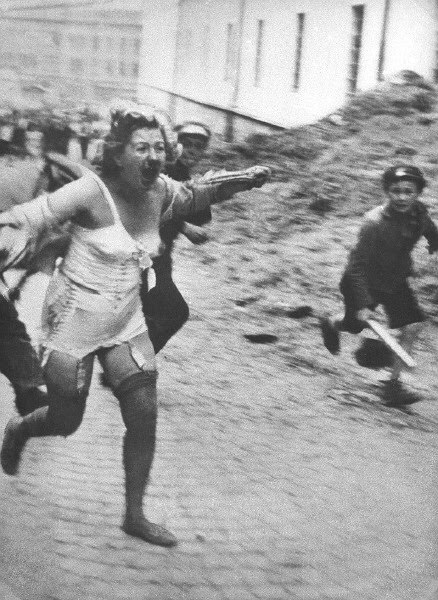 A woman desperately attempts to flee attackers in Lvov. (Photo credit: Wikipedia) |
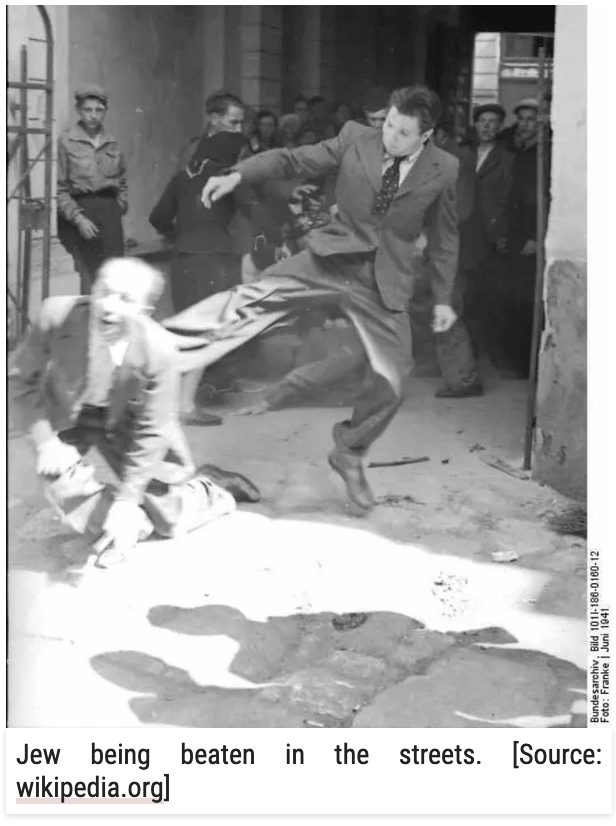 |
 |
 |
The more bloodthirsty and criminal members of the population apparently took the advice to heart, and in the bloody weeks that followed, thousands of Jews were terrorized throughout the city. Women were driven into the streets where they were stripped, raped and murdered. Men were kicked and beaten with fists and clubs. Throngs of nationalists threw trash at them as Nazi photographers went around gleefully filming the horror.
The Wehrmacht was eager to document these atrocities which were published in newspapers or shown in news reels back in Germany, to prove that the Nazis were serious about their plans to exterminate the untermenschen — the undesirables.
On that first bloody day alone, up to 5,000 Jews were massacred by the OUN, the Nazis and those who supported them.

Nazi photographers document atrocities in Lvov. Photo credit: Vintag.
The Einsatzgruppen came next. These were “professional” killers. Nazis who had already “cleansed” many villages, towns and cities in Poland and the USSR. They went door to door, dragged out their targets, marched them to pits which had already been prepared, forced them to their knees and executed them with bullets to the head. Nightingale and the OUN militias assisted them every step of the way, loading Jews onto trucks, then driving them to stadiums and executing them en masse with machine guns.
The Nazis stole everything of value, down to the gold fillings in their victims’ teeth, and sent it back to Germany where the money was used to fund industrialists who made enormous profits from Nazi extermination programs.
Thousands of people were slaughtered each day as Nightingale’s bloody talons tore into Lvov. As leaders of the OUN, including Shukhevich and Bandera, reigned in their high castle above the city, making their plans for an independent, Nazi-aligned Ukraine, the streets of Lvov and the surrounding region flowed with blood. By the time the Red Army arrived to liberate Lvov in 1944, only around 150,000 people remained and only 800 of them were Jews. The rest were either murdered or shipped off to the Belzec concentration camp, a slaughter-house so efficient that fewer than a dozen survivors were ever found.
The First Deputy Chief of the OUN under Stepan Bandera was Yaroslav Stetsko, who was named the first prime minister of the short-lived “Independent State of Ukraine” in 1941. In his “Act of Proclamation of Ukrainian Statehood,” he wrote:
“The newly-formed Ukrainian state will work closely with the National-Socialist Greater Germany, under the leadership of its leader Adolf Hitler which is forming a new order in Europe and the world and is helping the Ukrainian People to free itself from Muscovite occupation.”
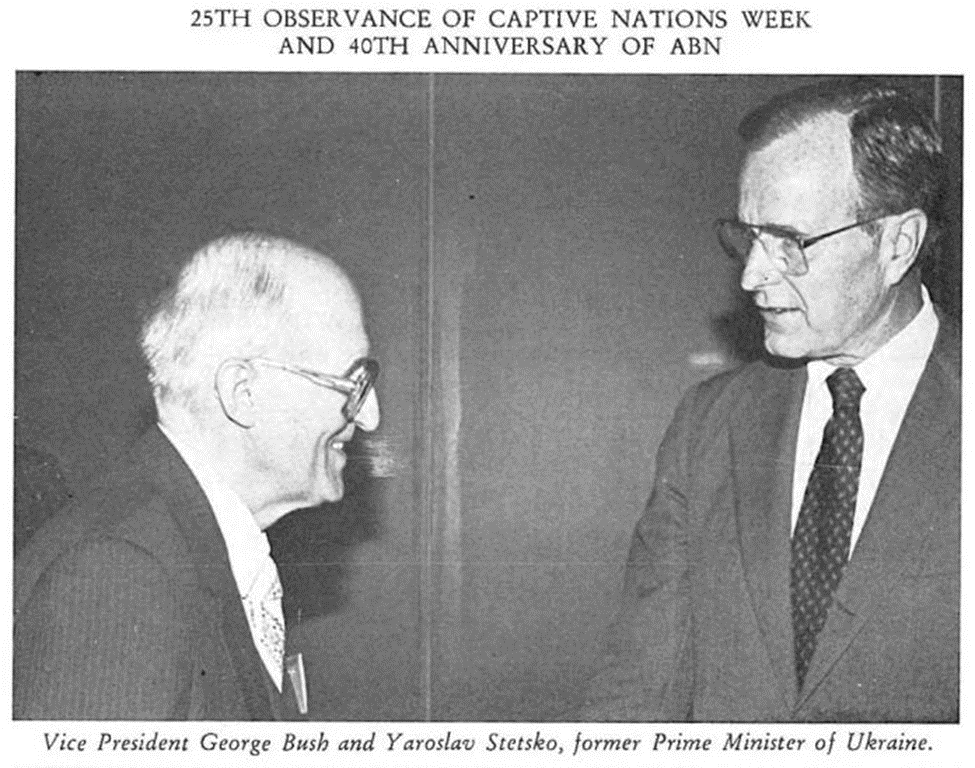
But…but… Bandera was sent to a concentration camp, so he couldn’t be bad!
Though the establishment of an independent Ukraine angered the OUN’s Nazi allies, who did not agree to it, it is grossly inaccurate to proclaim the OUN innocent of wrongdoing or to claim it was not a fascist organization. Even if the group had never collaborated with the Nazis, which it did, the OUN is guilty of enough atrocities against Jews, Poles, Russians, communists and Romani people to blacken its name forever in history as a brutal fascist organization.
In part one of this article, we looked at what the OUN did in Wołyń, where at least 100,000 people were massacred, most of them women and children. This was how the OUN operated. With brutality and hatred and no mercy whatsoever. They were violent fascists in their own right even if they had not collaborated with the Nazis. But of course, they did.
A Ukrainian Jew named Moshe Maltz wrote in his journal, later published as a memoir, while he was hiding from the Banderites:
“Bandera men … are not discriminating about who they kill; they are gunning down the populations of entire villages.… Since there are hardly any Jews left to kill, the Bandera gangs have turned on the Poles. They are literally hacking Poles to pieces. Every day … you can see the bodies of Poles, with wires around their necks, floating down the river Bug.”
After the declaration of Ukrainian independence, tensions rose until the Nazis arrested Bandera, Stetsko and other leaders of the OUN, and sent them to Sachsenhausen concentration camp in 1943.
Bandera, however, was not treated like a Jew, a Russian or any other untermensch. He was given a two-room suite with paintings and rugs and was not forced to perform any labor. He wore no uniform, ate with the guards and did not even lock his cell door at night. And he was allowed to have conjugal visits with his wife.
After less than a year, in 1944, Bandera was released and the Nazis recruited him, along with Stetsko, to carry out terrorist acts against the Red Army, which was now advancing on Germany.
The OUN did take minor retaliatory action against the Nazis in 1943, but it was slight compared to the campaign of terror the organization had previously waged against the Poles, Jews, Romani and other minorities.
Once again, it was civilians who bore the brunt of the OUN’s cruelty. In 1943, the Ukrainian nationalists killed around 12,000 “Germans” — mostly farmers and peasants under Nazi control. Only around 1,000 of these victims were actual Wehrmacht. Indeed, Soviet partisans reported that the OUN only engaged with Germans when the Germans mocked or attacked Ukrainians.
The Nazis handled this by simply transferring the more expendable Polish collaborators to the region to fight the OUN. And following the Soviet victory at Stalingrad, the OUN renewed its pact with the Nazis and reaffirmed the Soviets as their common enemy. There were little skirmishes between Nazis and OUN after that, but they were insignificant in the overall scope of their greater collaboration.
In 1943, the SS formed its Galicia Division, which incorporated members of the OUN. Modern Ukrainians have attempted to whitewash Galicia’s reputation, and marches in honor of this SS unit are a common sight in western Ukraine today.
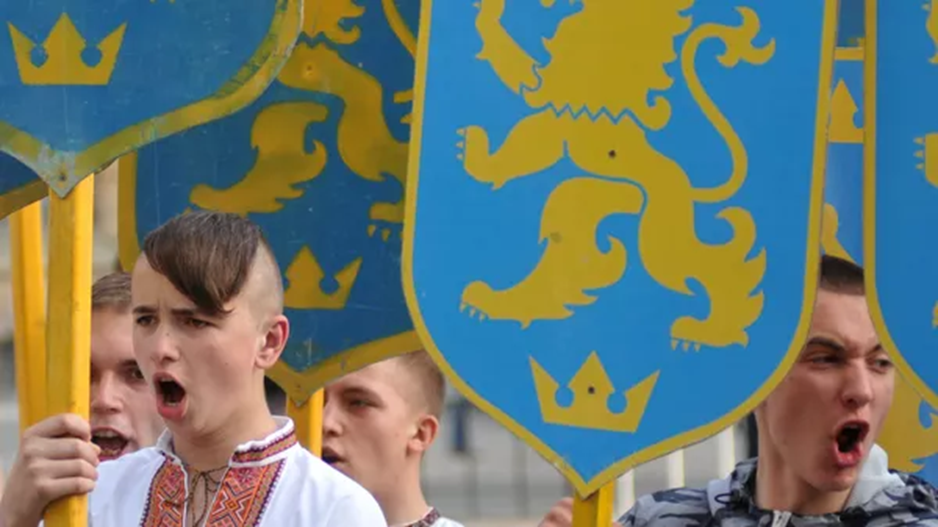
Ukrainian youth marching with the banner of the Galicia SS in 2018. Photo credit: RIA Novosti
“Russian Ukraine cannot be compared to Austrian Galicia… The Austrian-Galician Ruthenians are closely intertwined with the Austrian state. Therefore, in Galicia it is possible to allow the SS to form one division from the local population.”
— Adolf Hitler, 1942.
The OUN continued its terrorist rampage in western Ukraine until Soviet occupation of the region drove the fascist movement underground. In 1944, the OUN merged with other nationalist groups to form the Ukrainian Supreme Liberation Council, the UHVR, headed by Ivan Hrinioch, who had previously served as a chaplain in the Nightingale unit. Roman Shukhevich was killed in a raid by Soviet forces in 1950, bringing an end to the UPA for all intents and purposes.
But there always seem to be willing sponsors available to support Ukrainian fascists. If not overtly, then covertly.
Mykola Lebed became the foreign minister for the UHVR. As head of the OUN secret police, he was a known sadist and collaborator of the Germans, according to the US army. He later became a collaborator of the CIA, according to 1953 documents declassified in 2007.
But Bandera’s antagonism and volatility split the UHVR just as it had split the OUN previously. In 1947 Bandera and Stetsko fought with Lebed and Hrinioch over the issue of the largely Russian-speaking eastern Ukraine. Bandera demanded a purely Ukrainian state, purged of all Russian influence. Lebed and Hrinioch insisted that the help of eastern Ukrainians was needed for the success of the movement. Bandera expelled them in 1948, which led to the breakup of his brief courtship by the OSS, the forerunner of the CIA.
It was not long after the war when US Army Counterintelligence found Bandera in the American occupation zone, hiding from the Soviets who wanted him to face trial for his crimes. Their demands for his extradition were refused by the west.
A year later, in 1946, the Soviets made a failed attempt to capture him in Munich, where he was working under the protection of Reinhard Gehlen, a Nazi spy-turned-CIA agent. Gehlen helped countless Nazis to escape justice, including Adolf Eichmann, with the full support and backing of the CIA. In 1946, he was paid $3.5 million and he had 50 employees including 40 former SS. The CIA, in turn, used the Nazis as assets.
Bandera and the OUN secret police, the SB, formed by Lebed, served as assassins for MI6 as part of “Operation Ohio,” as it was codenamed. They hunted the refugee camps in post-war Germany for their targets, which included thousands of communists and anyone who might know too much about the OUN’s brutal reign of terror. Their terrifying reputation as hitmen earned Lebed the codename “Devil.”
The CIA valued Bandera as a potential asset because of the respect he commanded among the fascist underground. But he was far too extreme, unruly, and downright dangerous to work with, as he was uncooperative and often refused to use encrypted communications. He was just too much of a risk for the CIA to gamble with.
By 1954, the CIA forced MI6 to stop working with Bandera. That same year, Bandera was finally removed from OUN leadership. However, the CIA and the Germans continued to protect him from assassination attempts. He was guarded by Gehlen’s SS, the CIA, and the US Army Counterintelligence Corps.
The Soviets, meanwhile, had made repeated attempts to extradite Bandera so he could face trial for his war crimes. Every attempt was refused, so the KGB tried on several occasions to assassinate him, in 1947, 1948, 1952 and 1959.
Bandera continued his work for Gehlen for the remainder of his life, which ended in 1959 when a KGB agent named Bohdan Stashinsky finally succeeded in killing him. Stashinsky was an experienced assassin who had infiltrated the Bandera group in 1957 as a “German” and had already eliminated another leader of the OUN, Lev Rebet, using the same technique he was about to use on Bandera.
On October 15th, he followed Bandera to his home at Kristmanstrasse 7 in Munich where the mass-murderer was living under a false name. As his target reached the porch, Stashinsky quickly swallowed an antidote, then approached Bandera, who was struggling with the lock on the door. He asked his quarry if the key was working alright, and when Bandera raised his head to answer, Stashinsky blasted him in the face with a double-barreled cylinder loaded with ampoules of potassium cyanide. The instant he pressed the trigger, the powder charge broke the ampoules and the poison flew out. Bandera inhaled the toxic mist, causing his heart to stop. He collapsed, blood pouring from his mouth, and cracked his skull on the stairs.
The antidote protected Stashinsky, who quickly walked out of the entryway and disappeared into the night.
Initially, the cause of Bandera’s death was believed to be a stroke, which had caused him to fall. But investigators later discovered traces of potassium cyanide in his system. The name of his assassin was unknown until 1961, when love led Stashinsky to his eventual capture.
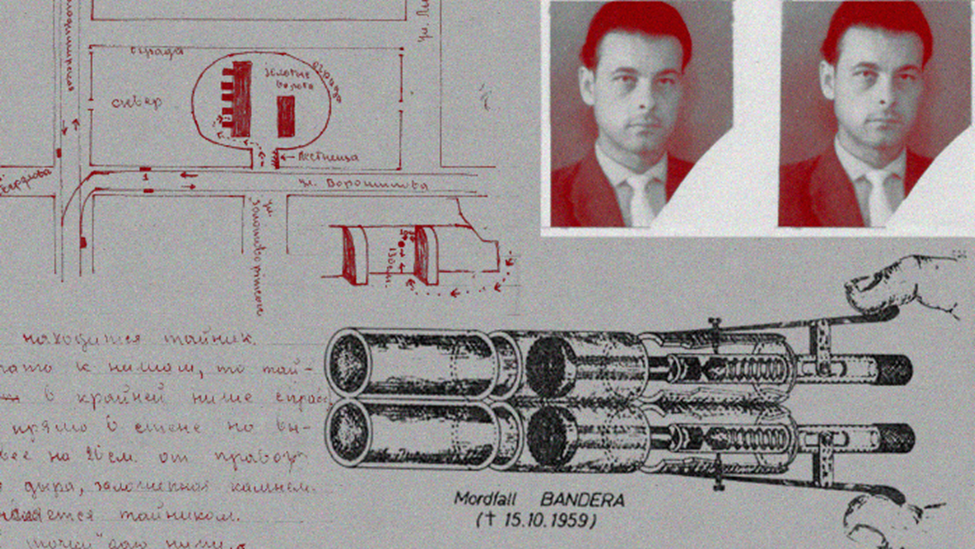
Bohdan Stashinsky, upper right, and a diagram of the specially-made poison gun he used to kill Bandera. Photo credit: RBTH
In Moscow, Bohdan Stashinsky was awarded the Order of the Red Banner. His handlers at the KGB, against their better judgment, also gave him permission to marry Inga Pol, an East German who had strong anti-communist leanings.
The couple settled in Moscow, but Inga returned to Germany to give birth to their son. Only four months later, their infant son died, and Stashinsky was allowed to go to the funeral in Germany. But he used the opportunity to flee to the west, instead.
On August 13, 1961, Stashinsky and his wife sneaked out of their house, leaving behind an unburied coffin containing their dead son. The smitten Stashinsky had confessed to his wife, against KGB instructions, of his involvement in the assassination of Bandera. Inga feared for her husband’s safety and convinced him to flee.
Stashinsky gave himself up to police in West Germany and was handed over to the CIA. He gave them detailed information about his activities in the KGB including the assassination of Stepan Bandera. He was sentenced to eight years in prison and Inga divorced him in 1964.
After his release in 1967, Stashinsky disappeared. Some sources claimed he stayed in the US and others claimed he fled to South Africa, perhaps changing his appearance with plastic surgery.
But no one knows if the man who killed Bandera is still alive today.
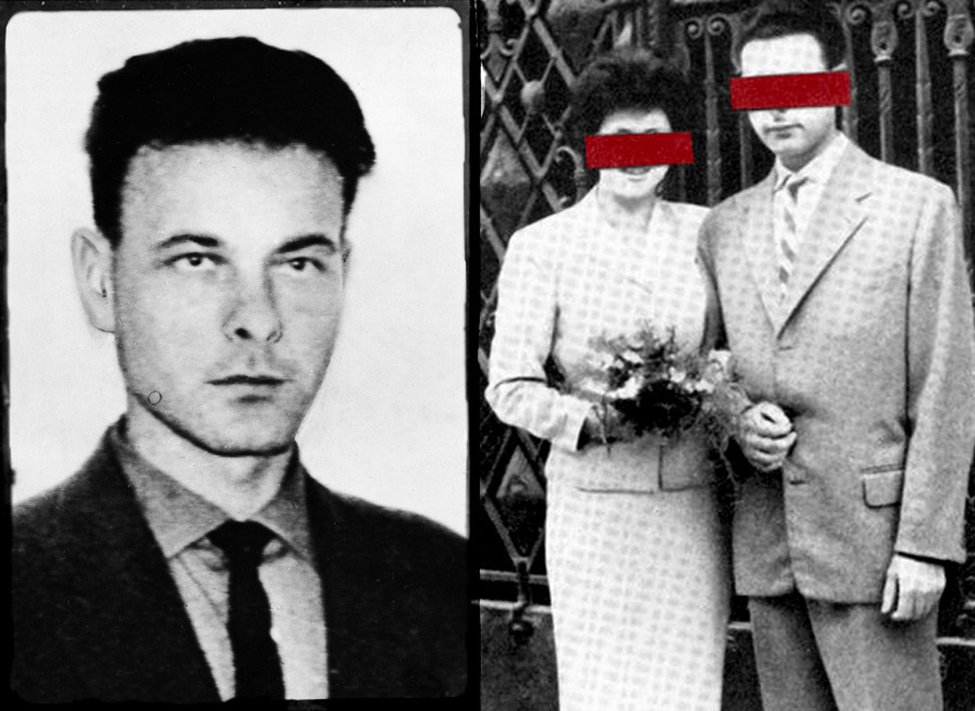
Bohdan Stashinsky and his wife, Inga. Photo source: RBTH
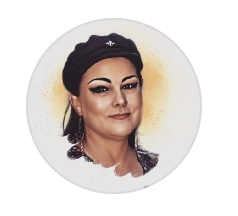 Deborah Armstrong currently writes about geopolitics with an emphasis on Russia. She previously worked in local TV news in the United States where she won two regional Emmy Awards. In the early 1990’s, Deborah lived in the Soviet Union during its final days and worked as a television consultant at Leningrad Television.
Deborah Armstrong currently writes about geopolitics with an emphasis on Russia. She previously worked in local TV news in the United States where she won two regional Emmy Awards. In the early 1990’s, Deborah lived in the Soviet Union during its final days and worked as a television consultant at Leningrad Television.https://medium.com/@deborahlarmstrong/the-nightingales-bloody-roost-5587863e7c2e
The views expressed herein are solely those of the author and may or may not reflect those of The Greanville Post. However, we do think they are important enough to be transmitted to a wider audience.

| Did you sign up yet for our FREE bulletin? |
[premium_newsticker id=”211406″]

This work is licensed under a Creative Commons Attribution-NonCommercial 4.0 International License
